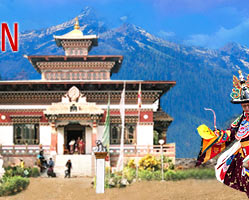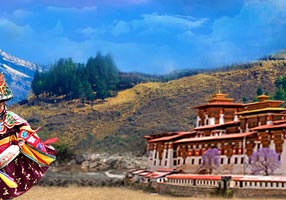Temples in Bhutan are known as Lhakhangs while monasteries are known as Gompas or Goenpas. They are found everywhere in the country, from every valley to every village to almost every mountain. They serve as the religious centers, as the venue for social and cultural functions and events and as a place for employment for laymen who work as help, artisans and agricultural laborers. Lhakhangs or temples in Bhutan can be a part of a dzong or a monastery as the main and central building or can be a separate building by itself. Some of the most sacred Bhutanese temples are situated outside the boundaries of dzongs and monasteries.
The temples are often surrounded by a courtyard lined with rows of prayer wheels on all four sides and pilgrims revolve them while circumambulating the temple. The courtyard forms the entrance of the temple and you have to cross it to reach the main shrine or the assembly room and the sanctum of the temple. The courtyard is used for communal gatherings, festivals and dance performances. Every temple as ‘gonkhangs’ or ‘chamber of horrors’, the secret chamber for Mahakala Vajra Bhairav, the chief protective deity of the Gelukpas. Here, the masks, weapons and skulls used in rituals, are kept. The origin of the gonkhang lies in the mixing of Mahayana tantric Buddhism and older beliefs.
‘Dukhangs’ in monasteries are large rooms devoted to communal ceremonies and shared meals. Roof of the temple has bell-shaped domes. The number of the domes depends upon the number of shrines attached to the temple. Templesand monasteries have an important place in Bhutanese history and saints and lamas often supervised their construction. Temples were considered to be the home of Gods and monasteries were solitary places where monks used to live and receive spiritual training. Both the places were used for prayer and meditation. Temple used to house only a few monks that were responsible for its maintenance and upkeep while monasteries often accommodated large community of over 100 monks who used to study and get trained there. Mani walls, chortens and prayer flags are often found around any religious building in
Bhutan and are some of the major architectural elements of temples and monasteries of Bhutan. Like most of the buildings, Bhutan’s temple and monastery too are made up of stone or rammed mud. Timber is used in their construction and they have shingle roofs. However, the interiors of these lhakhangs and gompas are quite different from vernacular houses. Walls painted in bright colors with symbols, designs and images of Buddhist deities, lamas and saints make these religious buildings unique. Monasteries may have chapels or lhakhands portraying protective spirits in most fearsome and angry forms that comes as a surprise to most visitors. They represent defenders of religion who can destroy any enemies around us.
The cockerel, snake and pig at the centre of the Wheel of Life symbolize desire, anger and ignorance in our hearts. Some Bhutanese temples are built in unusual shapes though. The Dungtse Lhakhang in the Paro valley, built in 1433, looks like a chorten. Thangtong Gyelpo, the famous chain-bridge builder, built it around a central axis and in the spirit of the mandala. The buildings of temples and monasteries are examples of exquisite architectural skills and fine craftsmanship. Though, the names of most of the founders of dzongs and monasteries are known, records related to the architects, workmen and artists who helped to build them, have not been maintained as the artistic creations in Bhutan are not considered a form of personal expression but the reflection of a shared state of mind.




